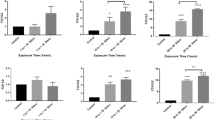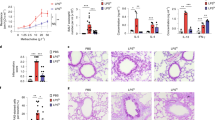Abstract
Exposure to organic dust from agricultural environments is associated with inflammatory respiratory conditions. The putative causal agents in organic dust include viral, microbial and fungal components, which are recognized by the family of Toll-like receptors (TLRs) and drive host innate and adaptive responses. Our aim in this study was to determine whether responsiveness to organic dust among agricultural workers was dependent on polymorphisms in the TLR10-TLR1-TLR6 gene cluster. We stimulated whole blood from 509 agricultural workers with organic dust, triacyl lipopeptide N-palmitoyl-S-dipalmitoylglyceryl Cys–Ser–(Lys)4 (Pam3CSK4) and the diacyl-lipopeptide peptidoglycan. Several of the tagging polymorphisms and haplotypes conferred hyper-responsiveness to organic dust with an increase in interleukin-6 (IL-6; P<0.005), but not tumor necrosis factor-α (TNF-α), secretion. We conclude that genetic variation in the TLR10-TLR1-TLR6 gene cluster mediates responsiveness to organic dust, but indicates different signaling pathways for IL-6 and TNF-α. These studies provide new insight into the role of the TLR10-TLR1-TLR6 gene cluster and the innate immune response to organic dust.
This is a preview of subscription content, access via your institution
Access options
Subscribe to this journal
Receive 6 digital issues and online access to articles
$119.00 per year
only $19.83 per issue
Buy this article
- Purchase on Springer Link
- Instant access to full article PDF
Prices may be subject to local taxes which are calculated during checkout

Similar content being viewed by others
References
Poole JA, Romberger DJ . Immunological and inflammatory responses to organic dust in agriculture. Curr Opin Allergy Clin Immunol 2012; 12: 126–132.
Linaker C, Smedley J . Respiratory illness in agricultural workers. Occup Med 2002; 52: 451–459.
Von Essen S, Donham K . Illness and injury in animal confinement workers. Occup Med 1999; 14: 337–350.
Boissy RJ, Romberger DJ, Roughead WA, Weissenburger-Moser L, Poole JA, LeVan TD . Shotgun pyrosequencing metagenomic analyses of dusts from swine confinement and grain facilities. PLoS One 2014; 9: e95578.
Poole JA, Dooley GP, Saito R, Burrell AM, Bailey KL, Romberger DJ et al. Muramic acid, endotoxin, 3-hydroxy fatty acids, and ergosterol content explain monocyte and epithelial cell inflammatory responses to agricultural dusts. J Toxicol Environ Health A 2010; 73: 684–700.
Poole JA, Alexis NE, Parks C, MacInnes AK, Gentry-Nielsen MJ, Fey PD et al. Repetitive organic dust exposure in vitro impairs macrophage differentiation and function. J Allergy Clin Immunol 2008; 122: 375–382, e1-e4.
Nehme B, Letourneau V, Forster RJ, Veillette M, Duchaine C . Culture-independent approach of the bacterial bioaerosol diversity in the standard swine confinement buildings, and assessment of the seasonal effect. Environ Microbiol 2008; 10: 665–675.
May S, Romberger DJ, Poole JA . Respiratory health effects of large animal farming environments. J Toxicol Environ Health B Crit Rev 2012; 15: 524–541.
Lee CC, Avalos AM, Ploegh HL . Accessory molecules for Toll-like receptors and their function. Nat Rev Immunol 2012; 12: 168–179.
Akira S, Takeda K, Kaisho T . Toll-like receptors: critical proteins linking innate and acquired immunity. Nat Immunol 2001; 2: 675–680.
Georgel P, Macquin C, Bahram S . The heterogeneous allelic repertoire of human toll-like receptor (TLR) genes. PLoS One 2009; 4: e7803.
Roach JC, Glusman G, Rowen L, Kaur A, Purcell MK, Smith KD et al. The evolution of vertebrate Toll-like receptors. Proc Natl Acad Sci USA 2005; 102: 9577–9582.
Zhou H, Gu J, Lamont SJ, Gu X . Evolutionary analysis for functional divergence of the toll-like receptor gene family and altered functional constraints. J Mol Evol 2007; 65: 119–123.
Takeuchi O, Sato S, Horiuchi T, Hoshino K, Takeda K, Dong Z et al. Cutting edge: role of Toll-like receptor 1 in mediating immune response to microbial lipoproteins. J Immunol 2002; 169: 10–14.
Takeuchi O, Kawai T, Muhlradt PF, Morr M, Radolf JD, Zychlinsky A et al. Discrimination of bacterial lipoproteins by Toll-like receptor 6. Int Immunol 2001; 13: 933–940.
Guan Y, Ranoa DR, Jiang S, Mutha SK, Li X, Baudry J et al. Human TLRs 10 and 1 share common mechanisms of innate immune sensing but not signaling. J Immunol 2010; 184: 5094–5103.
Okusawa T, Fujita M, Nakamura J, Into T, Yasuda M, Yoshimura A et al. Relationship between structures and biological activities of mycoplasmal diacylated lipopeptides and their recognition by toll-like receptors 2 and 6. Infect Immun 2004; 72: 1657–1665.
Takeuchi O, Hoshino K, Kawai T, Sanjo H, Takada H, Ogawa T et al. Differential roles of TLR2 and TLR4 in recognition of gram-negative and gram-positive bacterial cell wall components. Immunity 1999; 11: 443–451.
Oosting M, Cheng SC, Bolscher JM, Vestering-Stenger R, Plantinga TS, Verschueren IC et al. Human TLR10 is an anti-inflammatory pattern-recognition receptor. Proc Natl Acad Sci USA 2014; 111: E4478–E4484.
Arbour NC, Lorenz E, Schutte BC, Zabner J, Kline JN, Jones M et al. TLR4 mutations are associated with endotoxin hyporesponsiveness in humans. Nat Genet 2000; 25: 187–191.
Mikacenic C, Reiner AP, Holden TD, Nickerson DA, Wurfel MM . Variation in the TLR10/TLR1/TLR6 locus is the major genetic determinant of interindividual difference in TLR1/2-mediated responses. Genes Immunity 2013; 14: 52–57.
Wurfel MM, Gordon AC, Holden TD, Radella F, Strout J, Kajikawa O et al. Toll-like receptor 1 polymorphisms affect innate immune responses and outcomes in sepsis. Am J Respir Crit Care Med 2008; 178: 710–720.
Niebuhr M, Langnickel J, Draing C, Renz H, Kapp A, Werfel T . Dysregulation of toll-like receptor-2 (TLR-2)-induced effects in monocytes from patients with atopic dermatitis: impact of the TLR-2 R753Q polymorphism. Allergy 2008; 63: 728–734.
Sales ML, Schreiber R, Ferreira-Sae MC, Fernandes MN, Piveta CS, Cipolli JA et al. Toll-like receptor 6 Ser249Pro polymorphism is associated with lower left ventricular wall thickness and inflammatory response in hypertensive women. Am J Hypertens 2010; 23: 649–654.
Shey MS, Randhawa AK, Bowmaker M, Smith E, Scriba TJ, de Kock M et al. Single nucleotide polymorphisms in toll-like receptor 6 are associated with altered lipopeptide- and mycobacteria-induced interleukin-6 secretion. Genes Immun 2010; 11: 561–572.
Sherry ST, Ward MH, Kholodov M, Baker J, Phan L, Smigielski EM et al. dbSNP: the NCBI database of genetic variation. Nucleic Acids Res 2001; 29: 308–311.
Weissenburger-Moser L, Meza J, Yu F, Shiyanbola O, Romberger DJ, LeVan TD . A principal factor analysis to characterize agricultural exposures among Nebraska veterans. J Expo Sci Environ Epidemiol; e-pub ahead of print 6 April 2016; doi:10.1038/jes.2016.20.
U.S. Department of Veterans Affairs. National survey of veterans.: Hines, IL, USA, 2010. www.virec.research.va.gov.
Barrett JC, Fry B, Maller J, Daly MJ . Haploview: analysis and visualization of LD and haplotype maps. Bioinformatics 2005; 21: 263–265.
Imler JL, Hoffmann JA . Toll signaling: the TIReless quest for specificity. Nat Immunol 2003; 4: 105–106.
Kormann MS, Depner M, Hartl D, Klopp N, Illig T, Adamski J et al. Toll-like receptor heterodimer variants protect from childhood asthma. J Allergy Clin Immunol 2008; 122: 86–92 e1-8.
Yang CA, Chiang BL . Toll-like receptor 1 N248S polymorphism affects T helper 1 cytokine production and is associated with serum immunoglobulin E levels in Taiwanese allergic patients. J Microbiol Immunol Infect; e-pub ahead of print 30 January 2015; doi:10.1016/j.jmii.2015.01.004.
Barreiro LB, Ben-Ali M, Quach H, Laval G, Patin E, Pickrell JK et al. Evolutionary dynamics of human Toll-like receptors and their different contributions to host defense. PLoS Genet 2009; 5: e1000562.
Omueti KO, Mazur DJ, Thompson KS, Lyle EA, Tapping RI . The polymorphism P315L of human toll-like receptor 1 impairs innate immune sensing of microbial cell wall components. J Immunol 2007; 178: 6387–6394.
Johnson CM, Lyle EA, Omueti KO, Stepensky VA, Yegin O, Alpsoy E et al. Cutting edge: a common polymorphism impairs cell surface trafficking and functional responses of TLR1 but protects against leprosy. J Immunol 2007; 178: 7520–7524.
Hawn TR, Misch EA, Dunstan SJ, Thwaites GE, Lan NT, Quy HT et al. A common human TLR1 polymorphism regulates the innate immune response to lipopeptides. Eur J Immunol 2007; 37: 2280–2289.
Purdue MP, Lan Q, Wang SS, Kricker A, Menashe I, Zheng TZ et al. A pooled investigation of Toll-like receptor gene variants and risk of non-Hodgkin lymphoma. Carcinogenesis 2009; 30: 275–281.
Veltkamp M, van Moorsel CH, Rijkers GT, Ruven HJ, Grutters JC . Genetic variation in the Toll-like receptor gene cluster (TLR10-TLR1-TLR6) influences disease course in sarcoidosis. Tissue Antigens 2012; 79: 25–32.
Stevens VL, Hsing AW, Talbot JT, Zheng SL, Sun J, Chen J et al. Genetic variation in the toll-like receptor gene cluster (TLR10-TLR1-TLR6) and prostate cancer risk. Int J Cancer 2008; 123: 2644–2650.
Bank S, Andersen PS, Burisch J, Pedersen N, Roug S, Galsgaard J et al. Polymorphisms in the Toll-Like Receptor and the IL-23/IL-17 Pathways Were Associated with Susceptibility to Inflammatory Bowel Disease in a Danish Cohort. PLoS One 2015; 10: e0145302.
Rodrigues-Roisin R, Global Initiative for Chronic Obstructive Lung Disease Executive Committee. Global Strategy for the Diagnosis, Management and Prevention of COPD. Global Initiative for Chronic Obstructive Lung Disease (GOLD) 2008; 2014: 10.
Brazzale DJ, Hall GL, Pretto JJ . Effects of adopting the new global lung function initiative 2012 reference equations on the interpretation of spirometry. Respiration 2013; 86: 183–189.
Romberger DJ, Bodlak V, Von Essen SG, Mathisen T, Wyatt TA . Hog barn dust extract stimulates IL-8 and IL-6 release in human bronchial epithelial cells via PKC activation. J Appl Physiol 2002; 93: 289–296.
National Heart, Lung, and Blood Institute, NIH. Genome Variation Server. Bethesda, MD, USA, 2007. http://snp.gs.washington.edu/SeattleSeqAnnotation147/HelpAbout.jsp (accessed on 10 August 2007).
Benjamini Y, Hochbery Y . Controlling the false discovery rate: a practical and powerful approach to multiple testing. J Royal Stat Soc Ser B 1995; 57: 289–300.
Lake SL, Lyon H, Tantisira K, Silverman EK, Weiss ST, Laird NM et al. Estimation and tests of haplotype-environment interaction when linkage phase is ambiguous. Human Hered 2003; 55: 56–65.
Acknowledgements
We would like to acknowledge our VA Merit funding for this collaboration (VA Merit Awards to TDL (1I01CX000434-01) and DJR), the hard work by the study coordinators Robin Zotti-Pierce, Eric Chickris, Meghan Langel and Kelsey Palm.
Author information
Authors and Affiliations
Corresponding author
Ethics declarations
Competing interests
The authors declare no conflict of interest.
Additional information
Supplementary Information accompanies this paper on Genes and Immunity website
Supplementary information
Rights and permissions
About this article
Cite this article
Smith, L., Weissenburger-Moser, L., Heires, A. et al. Epistatic effect of TLR-1, -6 and -10 polymorphisms on organic dust-mediated cytokine response. Genes Immun 18, 67–74 (2017). https://doi.org/10.1038/gene.2016.51
Received:
Revised:
Accepted:
Published:
Issue Date:
DOI: https://doi.org/10.1038/gene.2016.51
This article is cited by
-
Cell death in cancer in the era of precision medicine
Genes & Immunity (2019)
-
Cell death pathologies: targeting death pathways and the immune system for cancer therapy
Genes & Immunity (2019)
-
Relationship of systemic IL-10 levels with proinflammatory cytokine responsiveness and lung function in agriculture workers
Respiratory Research (2018)



